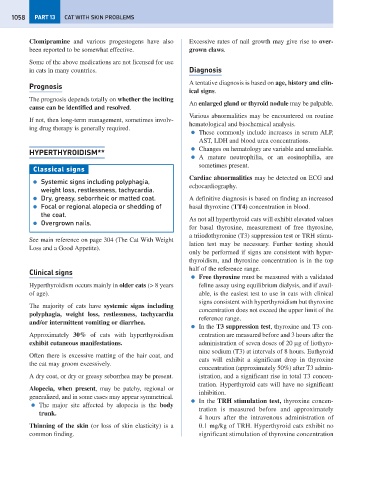Page 1066 - Problem-Based Feline Medicine
P. 1066
1058 PART 13 CAT WITH SKIN PROBLEMS
Clomipramine and various progestogens have also Excessive rates of nail growth may give rise to over-
been reported to be somewhat effective. grown claws.
Some of the above medications are not licensed for use
in cats in many countries. Diagnosis
A tentative diagnosis is based on age, history and clin-
Prognosis
ical signs.
The prognosis depends totally on whether the inciting
An enlarged gland or thyroid nodule may be palpable.
cause can be identified and resolved.
Various abnormalities may be encountered on routine
If not, then long-term management, sometimes involv-
hematological and biochemical analysis.
ing drug therapy is generally required.
● These commonly include increases in serum ALP,
AST, LDH and blood urea concentrations.
● Changes on hematology are variable and unreliable.
HYPERTHYROIDISM**
● A mature neutrophilia, or an eosinophilia, are
sometimes present.
Classical signs
Cardiac abnormalities may be detected on ECG and
● Systemic signs including polyphagia,
echocardiography.
weight loss, restlessness, tachycardia.
● Dry, greasy, seborrheic or matted coat. A definitive diagnosis is based on finding an increased
● Focal or regional alopecia or shedding of basal thyroxine (TT4) concentration in blood.
the coat.
As not all hyperthyroid cats will exhibit elevated values
● Overgrown nails.
for basal thyroxine, measurement of free thyroxine,
a triiodothyronine (T3) suppression test or TRH stimu-
See main reference on page 304 (The Cat With Weight
lation test may be necessary. Further testing should
Loss and a Good Appetite).
only be performed if signs are consistent with hyper-
thyroidism, and thyroxine concentration is in the top
half of the reference range.
Clinical signs
● Free thyroxine must be measured with a validated
Hyperthyroidism occurs mainly in older cats (> 8 years feline assay using equilibrium dialysis, and if avail-
of age). able, is the easiest test to use in cats with clinical
signs consistent with hyperthyroidism but thyroxine
The majority of cats have systemic signs including
concentration does not exceed the upper limit of the
polyphagia, weight loss, restlessness, tachycardia
reference range.
and/or intermittent vomiting or diarrhea.
● In the T3 suppression test, thyroxine and T3 con-
Approximately 30% of cats with hyperthyroidism centration are measured before and 3 hours after the
exhibit cutaneous manifestations. administration of seven doses of 20 μg of liothyro-
nine sodium (T3) at intervals of 8 hours. Euthyroid
Often there is excessive matting of the hair coat, and
cats will exhibit a significant drop in thyroxine
the cat may groom excessively.
concentration (approximately 50%) after T3 admin-
A dry coat, or dry or greasy seborrhea may be present. istration, and a significant rise in total T3 concen-
tration. Hyperthyroid cats will have no significant
Alopecia, when present, may be patchy, regional or
inhibition.
generalized, and in some cases may appear symmetrical.
● In the TRH stimulation test, thyroxine concen-
● The major site affected by alopecia is the body
tration is measured before and approximately
trunk.
4 hours after the intravenous administration of
Thinning of the skin (or loss of skin elasticity) is a 0.1 mg/kg of TRH. Hyperthyroid cats exhibit no
common finding. significant stimulation of thyroxine concentration

